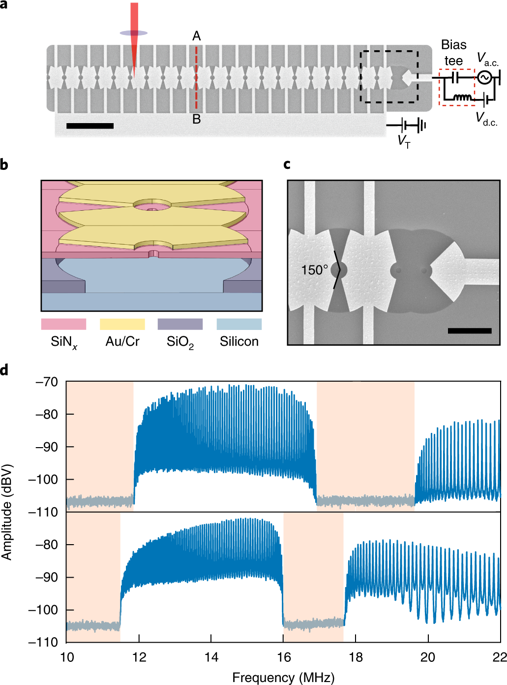Nature Nanotechnology ( IF 38.1 ) Pub Date : 2018-09-10 , DOI: 10.1038/s41565-018-0252-6 Jinwoong Cha , Chiara Daraio

|
Nanoelectromechanical systems (NEMS) that operate in the megahertz (MHz) regime allow energy transducibility between different physical domains. For example, they convert optical or electrical signals into mechanical motions and vice versa1. This coupling of different physical quantities leads to frequency-tunable NEMS resonators via electromechanical non-linearities2,3,4. NEMS platforms with single- or low-degrees of freedom have been employed to demonstrate quantum-like effects, such as mode cooling5, mechanically induced transparency5, Rabi oscillation6,7, two-mode squeezing8 and phonon lasing9. Periodic arrays of NEMS resonators with architected unit cells enable fundamental studies of lattice-based solid-state phenomena, such as bandgaps10,11, energy transport10,11,12, non-linear dynamics and localization13,14, and topological properties15, directly transferrable to on-chip devices. Here we describe one-dimensional, non-linear, nanoelectromechanical lattices (NEML) with active control of the frequency band dispersion in the radio-frequency domain (10–30 MHz). The design of our systems is inspired by NEMS-based phonon waveguides10,11 and includes the voltage-induced frequency tuning of the individual resonators2,3,4. Our NEMLs consist of a periodic arrangement of mechanically coupled, free-standing nanomembranes with circular clamped boundaries. This design forms a flexural phononic crystal with a well-defined bandgap, 1.8 MHz wide. The application of a d.c. gate voltage creates voltage-dependent on-site potentials, which can significantly shift the frequency bands of the device. Additionally, a dynamic modulation of the voltage triggers non-linear effects, which induce the formation of a phononic bandgap in the acoustic branch, analogous to Peierls transition in condensed matter16. The gating approach employed here makes the devices more compact than recently proposed systems, whose tunability mostly relies on materials’ compliance17,18 and mechanical non-linearities19,20,21,22.
中文翻译:

纳米波频率下纳米力学晶格中弹性波传播的电调谐
在兆赫兹(MHz)范围内运行的纳米机电系统(NEMS)允许在不同物理域之间进行能量转换。例如,它们将光或电信号转换为机械运动,反之亦然1。不同物理量的这种耦合通过机电非线性2,3,4导致频率可调的NEMS谐振器。已使用具有单自由度或低自由度的NEMS平台来展示类似量子的效应,例如模式冷却5,机械感应的透明5,拉比振荡6,7,双模式压缩8和声子激光9。。具有结构化晶胞的NEMS谐振器的周期性阵列可以对基于晶格的固态现象(例如带隙10,11,能量传输10,11,12,非线性动力学和局部化13,14和拓扑特性15)进行基础研究。,可以直接转移到片上设备。在这里,我们描述了一维,非线性,纳米机电晶格(NEML),它具有对射频域(10–30 MHz)中频带分散的主动控制。我们系统的设计受到基于NEMS的声子波导10,11的启发,并且包括各个谐振器2,3,4的电压感应频率调谐。我们的NEML包括周期性排列的机械耦合,具有圆形夹紧边界的独立式纳米膜。这种设计形成了具有清晰定义的带隙,1.8 MHz宽度的弯曲声子晶体。直流栅极电压的施加会产生电压相关的现场电势,这可能会极大地改变设备的频带。另外,电压的动态调制触发非线性效应,该非线性效应引起声分支中声子带隙的形成,类似于冷凝物16中的Peierls跃迁。这里采用的门控方法使设备比最近提出的系统更紧凑,其可调谐性主要取决于材料的柔度17,18和机械非线性19,20,21,22。











































 京公网安备 11010802027423号
京公网安备 11010802027423号